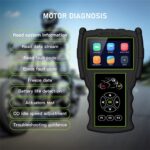Understanding your vehicle’s health is no longer confined to professional mechanics. Modern cars are equipped with sophisticated On-Board Diagnostics (OBD) systems, acting as the vehicle’s internal health monitor. These systems, particularly OBD2, offer significant advantages to both car owners and technicians by providing crucial insights into a vehicle’s operational status and potential issues. An Obd2 Scanner Laptop takes this diagnostic capability a step further, harnessing the power of your computer for in-depth vehicle analysis.
The primary role of an OBD system is to oversee your vehicle’s emissions system and other critical diagnostic parameters. It continuously monitors various sensors and components, detecting any deviations from normal operation. This early detection is invaluable, allowing for timely intervention and preventing minor issues from escalating into costly repairs. When the OBD2 system detects a problem, it stores diagnostic trouble codes (DTCs) and often illuminates the “check engine light” on your dashboard. Furthermore, OBD2 systems capture a snapshot of data at the moment a fault occurs, providing technicians with valuable context for diagnosis. Beyond fault detection, OBD2 systems also stream real-time data from your vehicle’s sensors. This data stream includes parameters like engine speed (RPM), vehicle speed, engine temperature, and fuel consumption, empowering users to monitor performance and even calculate fuel efficiency.
To access this wealth of information, the OBD2 diagnostic connector is the gateway. Standardized across all modern vehicles, this 16-pin connector is typically located within easy reach on the driver’s side, usually beneath the steering wheel. Connecting to this port requires a scan tool, and this is where the OBD2 scanner laptop solution shines. Scan tools broadly fall into two categories: standalone handheld devices and PC/Mobile-based systems. Standalone scan tools, while convenient in their portability, often come with limitations. They can be expensive, possess restricted functionality, lack advanced diagnostic features, and are generally not upgradeable to keep pace with evolving vehicle technology.
In contrast, an OBD2 scanner laptop leverages the processing power, versatility, and upgradeability of modern computers. These systems consist of an OBD2 adapter that plugs into your vehicle’s diagnostic port and software installed on your laptop. The adapter communicates with the laptop via USB, Bluetooth, or Wi-Fi, transmitting the OBD2 data for analysis and display. The advantages of using an OBD2 scanner laptop are compelling. Firstly, laptops offer significantly more processing power and display capabilities compared to handheld devices, enabling more sophisticated diagnostics, data visualization, and reporting. Secondly, OBD2 scanner laptop software is frequently updated, ensuring compatibility with the latest vehicle models and diagnostic protocols, a crucial aspect in the rapidly evolving automotive industry. Finally, the cost-effectiveness of an OBD2 scanner laptop solution is often superior, as you are utilizing a device you likely already own and investing primarily in the adapter and software, rather than a dedicated, and potentially less versatile, handheld tool.
In conclusion, for comprehensive and future-proof vehicle diagnostics, an OBD2 scanner laptop presents a powerful and intelligent solution. It combines the robust diagnostic capabilities of OBD2 systems with the flexibility and power of modern computing, making advanced vehicle health monitoring accessible and affordable for both enthusiasts and professionals. By choosing an OBD2 scanner laptop, you are equipping yourself with a tool that can grow with your needs and provide invaluable insights into your vehicle’s performance and well-being.
